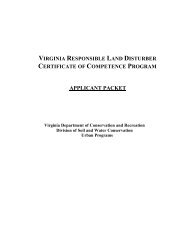Dameron Marsh NAP self-guided field trip guide - Virginia ...
Dameron Marsh NAP self-guided field trip guide - Virginia ...
Dameron Marsh NAP self-guided field trip guide - Virginia ...
You also want an ePaper? Increase the reach of your titles
YUMPU automatically turns print PDFs into web optimized ePapers that Google loves.
Stop 3...<br />
• Notice that the trail is sometimes underwater here —good evidence of changes in hydrologic conditions due to<br />
rainfall.<br />
• Old <strong>field</strong> succession. The seeds of most of the plant sequences that will cover an abandoned <strong>field</strong> in the years to<br />
come are there at abandonment but won’t germinate all at once or under the same conditions. Grasses germinate<br />
well in bare soil are some of the first colonizers of old <strong>field</strong>s. Soon other plants such as goldenrod and camphor<br />
weed make their way into the line up, followed by shrubs and pioneer trees such as persimmon, black gum,<br />
cherry, pine and red cedar. Eventually these <strong>field</strong>s will be forested wetlands comprised primarily of Loblolly<br />
Pine. This is a community we call Maritime Loblolly Pine Forest. Because these same forests are made up of<br />
different species of trees to the north and south of us—the maritime loblolly pine forest in <strong>Virginia</strong> is considered<br />
a globally rare community.<br />
• Look up for eagles, marsh hawks or vultures wheeling overhead.<br />
• There are several species of sedges here if you look closely...- Remember the old mnemonic “Sedges have<br />
edges, rushes are round, grasses are hollow right up from the ground”. It is pretty reliable though not absolute.<br />
Most sedges have a triangular shaped stem “the edges”, narrow leaves arranged in threes and prefer wet places.<br />
Many have an umbrella shape. Towards the top of the stalk there will be 3-5 leaves extending horizontally, and<br />
radiating above that will be spiky ‘flowers’, usually yellow or brown. There are literally dozens of species of<br />
sedges (Cyperus, scirpus, carex, etc.) and are often difficult to distinguish from each other.<br />
A nut sedge Cyperus spp?<br />
Persimmon trees<br />
Diospyrosora virginiana<br />
Narrow leaved cat tail<br />
Typha angustifolia
















